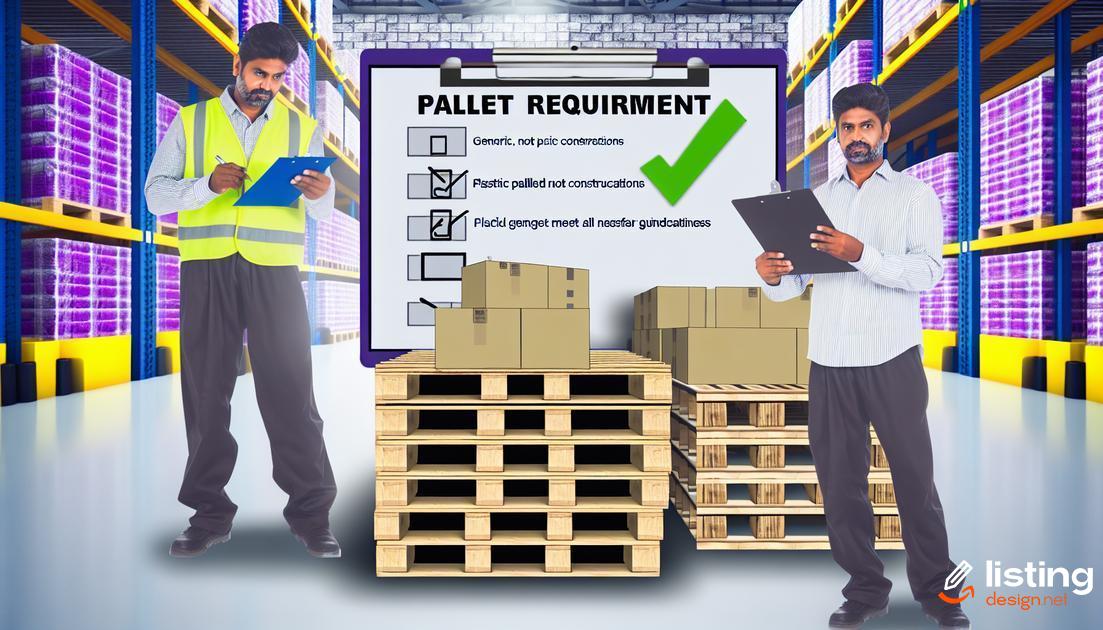Amazon FBA pallet guidelines are crucial for sellers looking to optimize their shipping process. Understanding these guidelines ensures your shipments are accepted without delays, saving you time and money. In this post, we’ll uncover essential tips and best practices, helping you navigate Amazon’s requirements with ease. By following these guidelines, you can enhance your shipping efficiency and avoid common pitfalls.
Table of Contents
Why Follow Amazon FBA Pallet Guidelines?
Adhering to Amazon FBA pallet guidelines is crucial for maintaining smooth and efficient warehouse operations. These guidelines help ensure that your products are handled properly by Amazon’s fulfillment centers, reducing the risk of damage and delays.
Amazon’s rigorous standards are set to optimize storage space and improve the safety of manual and mechanical handling processes. Following these guidelines can ultimately enhance your selling performance and customer satisfaction.
Compliance with pallet guidelines also minimizes the chances of receiving penalties from Amazon, such as additional fees or rejected shipments. By aligning with these requirements, sellers can benefit from a more streamlined shipping process and can avoid costly mistakes.
Professionalism
is another key reason to follow Amazon’s FBA pallet guidelines. It reflects positively on your business and shows that you are a responsible and reliable seller. This can significantly enhance your reputation and increase trust with both Amazon and your customers.
Understanding Amazon’s Pallet Requirements

When preparing your shipments for Amazon FBA, adhering to Amazon’s pallet requirements is crucial. Ensuring that your pallets meet these requirements can help you avoid costly delays and rejections at the fulfillment center.
Pallet Dimensions: Standard pallets should ideally measure 40 inches by 48 inches. These dimensions help maintain consistency and efficiency in Amazon’s warehousing operations.
Quality of Pallets: Use sturdy, four-way pallets in good condition, free of any damage or contamination. Pallets should be able to support the weight of the goods without collapsing.
Weight Limitations: Each pallet should not exceed 1,500 pounds in weight. Overloading pallets can lead to structural failures and pose a hazard during handling and transport.
Height Restrictions: The maximum allowable height, including the pallet, is 72 inches. This helps ensure safe stacking and transport within Amazon’s fulfillment centers.
Labeling: Each pallet should be clearly labeled with appropriate identification, including the shipment ID, pallet ID, and any other pertinent information required by Amazon. This ensures accurate tracking and processing of your shipments.
Securing Shipments: Pallets should be securely wrapped with stretch film to prevent shifting of goods during transit. Use strapping if necessary to provide additional stability.
By following these guidelines, you can optimize the efficiency of your Amazon FBA shipments, reduce the risk of damage, and ensure timely processing at fulfillment centers.
Acceptable Pallet Types for Amazon FBA
When preparing shipments for Amazon FBA, it is crucial to use acceptable pallet types to ensure smooth processing and compliance with Amazon’s guidelines. The preferred pallet type is the 40 x 48 inches wooden GMA (Grocery Manufacturers Association) pallet. These pallets are widely available and meet the required specifications. Other acceptable pallet types include:
- EURO pallets: Measuring 47.2 x 39.4 inches, these are common but less preferred due to size variations.
- Plastic pallets: Durable and reusable, plastic pallets must meet the same size requirements as wooden pallets.
- ISPM-15 compliant pallets: Essential for international shipments, these pallets are treated to prevent pest infestations.
It’s important to note that pallets should be in good condition, free from damage, and capable of supporting the weight of the shipment. Avoid using pallets with broken boards, protruding nails, or other structural issues, as these can lead to rejection at the fulfillment center.
Dimensions and Weight Limitations

When it comes to shipping to Amazon FBA, it’s crucial to ensure that your pallets adhere to the specified dimensions and weight limitations. This will not only prevent any potential delays but also avoid additional fees.
Standard Dimensions
Amazon has specified that pallets should be 48 inches long by 40 inches wide. This dimension is standard and ensures that pallets can be easily handled through Amazon’s fulfillment network. Ensure that your pallet does not exceed these dimensions.
Height Limitations
The maximum height allowed for a pallet, including the pallet itself, is 72 inches. This height restriction helps maintain stability during transportation and storage. Overly tall pallets risk toppling over, which could lead to damage and safety hazards.
Weight Limitations
Each pallet should not exceed a maximum weight of 1500 pounds. Exceeding this weight limit can compromise the handling safety of the pallet, thereby risking damage to the products and potentially causing injuries during loading and unloading processes.
Guidance for Overweight or Oversized Items
If your product exceeds the standard pallet size or weight restrictions, consider breaking down the shipment into smaller, manageable units. Alternatively, consult with Amazon for tailored solutions that meet both your shipping needs and Amazon’s guidelines.
Keeping the dimensions and weight within Amazon’s specified limitations will facilitate smoother processing and quicker arrival to the FBA center, ultimately creating a better experience for your customers.
Proper Labeling Practices
Ensuring proper labeling of your pallets is crucial for smooth processing at Amazon FBA centers. Labels help in identifying products and streamlining logistics. Here are some key practices:
Label Placement
Place labels on all four sides of the pallet. This ensures visibility from any angle, reducing handling time.
Ensure Legibility
Labels must be clear and easy to read. Use a large font size and avoid any smudging. High-quality printing is essential.
Use Amazon-Compatible Labels
Only use labels that meet Amazon’s specifications. Incorrect labels can lead to delays and additional costs.
Include All Required Information
Each label should contain the shipment ID, destination, and other necessary details as specified by Amazon.
Double Check for Accuracy
Before shipping, double-check that all information is correct. Incorrect information can cause significant delays.
Secure Labels Properly
Labels should be securely attached to the pallets to prevent them from falling off during transit. Use adhesive labels or strong tape for this purpose.
By following these practices, you ensure that your shipments are accurately and quickly processed at the FBA centers, leading to a smoother operation overall.
Pallet Configuration and Stacking Rules

When preparing pallets for Amazon FBA, adhering to the correct configuration and stacking rules is vital. First, ensure that boxes are positioned evenly on the pallet, avoiding any overhang. This helps prevent damage during transit.
Stacking Height
Never stack pallets higher than 72 inches. Keep in mind that the combined height of the pallet and the products should not exceed this limit.
Distribute Weight Evenly
It’s crucial to distribute the weight evenly across the pallet. Place heavier items at the bottom for stability.
Use Pallet Ties and Stretch Wrap
Secure your boxes with pallet ties or stretch wrap to ensure they remain in place. This will help avoid shifting or toppling over.
Corrugate Each Layer
For added stability, use a corrugated sheet between layers. This can help protect the products and add rigidity to the stack. Following these configuration and stacking rules will help ensure your shipment adheres to Amazon’s guidelines and arrives safely at the fulfillment center.
Securing Your Pallet Shipment
One of the crucial steps in ensuring your items reach their destination safely is securing the pallet shipment. Properly secured pallets minimize the risk of product damage and help maintain the integrity of the shipment.
To secure your pallet, use high-quality wrapping materials such as stretch film, which provides a tight seal around the products and the pallet itself. Additionally, consider using corner boards to protect the edges of the pallet and reinforce stability.
Employ strapping techniques to enhance security. Polyester or metal strapping can be used to bind the items together firmly. Ensure the straps are tightly fastened and regularly check for any signs of loosening during transit.
Another effective measure is utilizing pallet covers or caps to shield the shipment from dust, moisture, and other environmental elements. These covers provide an additional layer of protection, especially during long-distance transportation.
During the loading process, ensure the pallet is properly balanced and evenly distributed. Uneven weight distribution can lead to tipping or falling over, posing significant risks to the products and handlers.
Finally, label the pallet clearly with all necessary shipping information, including addresses, contact numbers, and any special handling instructions. Proper labeling helps in smooth tracking and helps prevent misrouting or delayed deliveries.
Common Mistakes to Avoid

Many sellers often make the mistake of overloading pallets which can lead to damage during transit and refusal by Amazon’s fulfillment centers.
Another common mistake is improper labeling. Incorrect or missing labels can cause delays in shipment processing or even rejection by Amazon.
Using non-compliant pallet dimensions is a frequent error. Ensure your pallets meet Amazon’s size specifications to avoid complications.
Failure to secure pallets properly is another critical mistake. Always use strong shrink wrap and strapping to ensure the stability of the load.
Sellers sometimes ignore the weight limitations for pallets. Exceeding the weight limit can lead to handling issues and potential rejection.
Choosing the wrong type of pallets can cause significant issues. Ensure you are using the correct quality and type as specified by Amazon.
Benefits of Adhering to Pallet Guidelines
Adhering to Amazon FBA pallet guidelines ensures smooth warehouse operations and reduces the risk of damage to your goods. It helps streamline the entire logistics process, making it more efficient and cost-effective.
By following these guidelines, sellers can reduce delays in receiving and processing their shipments, which can lead to faster availability of products for sale. This ultimately enhances customer satisfaction as products can be fulfilled and shipped more quickly, leading to better reviews and increased sales.
Adherence to pallet guidelines also plays a crucial role in preventing costly penalties or rejections from Amazon. By avoiding non-compliance issues, sellers can save money and avoid the hassle of corrective actions.
Moreover, proper palletization supports worker safety in the warehouse by ensuring that pallets are stable and easy to handle. This minimizes the risk of accidents and injuries, contributing to a safer working environment.
Overall, following these guidelines leads to more efficient logistics operations, cost savings, and a better seller reputation on the Amazon platform. Complying with the rules is crucial for seamless inventory management and a successful FBA business.
How to Save on Shipping Costs

Shipping costs can significantly impact your bottom line. To minimize these expenses, consider the following strategies:
Optimize Your Packaging:
Use appropriately sized boxes to avoid dimensional weight charges. Lightweight yet sturdy materials can protect your products without adding to the shipping weight.
Consolidate Shipments:
Whenever possible, combine orders to be shipped together. This can reduce the number of shipments, cutting down both shipping costs and packaging materials.
Choose Economical Shipping Options:
Opt for slower, more cost-effective shipping methods if time permits. Evaluate the rates and delivery times from different carriers to find the best balance between cost and speed.
Automate Your Shipping Process:
Invest in shipping software to streamline your operations. Automation can help in comparing rates, printing shipping labels, and tracking shipments, saving both time and money.
Negotiate with Carriers:
If you have a high volume of shipments, negotiate for better rates with your carriers. Many carriers offer discounts based on the volume of regular shipments.
Utilize Carrier Discounts:
Look out for seasonal discounts and promotional rates from various carriers. Joining carrier loyalty programs can also provide significant savings over time.
Amazon FBA Multi-Channel Fulfillment:
Consider using Amazon’s Multi-Channel Fulfillment service. Amazon FBA often has competitive shipping rates for fulfilling orders across multiple channels, including your own website.
Review and Adjust Regularly:
Continuously review your shipping expenses and adjust your strategies as necessary. Stay informed about changes in shipping rates and policies to adapt quickly and maintain cost-efficiency.
Tips for New Amazon FBA Sellers
Allocate Sufficient Capital: As a new seller, ensure you have enough capital to cover initial expenses, inventory, shipping, and marketing. Balancing your budget is crucial to the success of your business.
Research Your Niche: Dive deep into market research to find a profitable niche. Use tools like Jungle Scout or Helium 10 to understand market demand, competition, and potential profit margins.
Source Reliable Suppliers: Establish relationships with trustworthy suppliers. Websites like Alibaba can help, but always vet your suppliers and consider ordering samples before committing.
Optimize Product Listings: Pay attention to SEO when creating product listings. Use relevant keywords, clear images, and informative descriptions to attract potential buyers.
Take Advantage of FBA Tools: Amazon offers a variety of tools to help sellers. Utilize these resources, such as Amazon Seller Central, to manage your inventory, track shipments, and analyze sales data effectively.
Monitor Inventory Levels: Keeping an eye on your stock levels is essential to avoid running out of inventory or overstocking. Utilize Amazon’s inventory management tools to stay on top of this.
Understand Fees: FBA comes with various fees, including storage and fulfillment fees. Make sure you understand these costs and factor them into your pricing strategy.
Invest in Advertising: Sponsored ads on Amazon can significantly boost visibility. Allocate part of your budget to PPC (Pay-Per-Click) advertising campaigns to drive traffic to your listings.
Focus on Customer Service: Providing excellent customer service helps maintain high seller ratings. Respond promptly to customer inquiries and address any issues to build a loyal customer base.
Continuously Learn: Stay updated on Amazon’s policies and trends in e-commerce. Join forums, attend webinars, and network with other sellers to continuously improve your knowledge and strategies.
Conclusion: Maximize Efficiency with Proper Guidelines

Ensuring your pallets meet Amazon’s FBA guidelines can significantly enhance your operational efficiency. By adhering to these best practices, you minimize delays and avoid extra fees. Remember to label your pallets properly and follow all weight and size restrictions. This attention to detail will streamline your fulfillment process and elevate your seller performance.
Taking the time to understand and implement these requirements will undoubtedly pay off in the long run. Focus on accuracy and quality in your pallet preparation to maintain a smooth supply chain.


